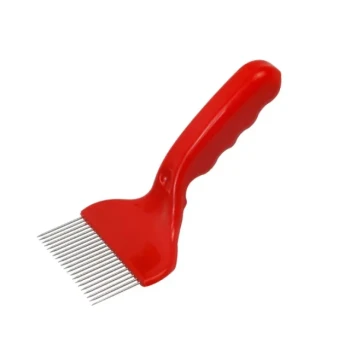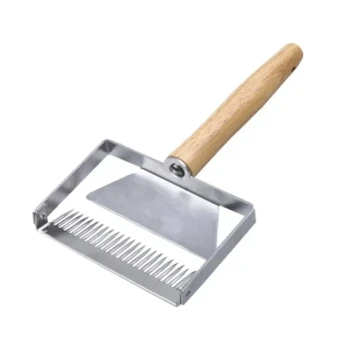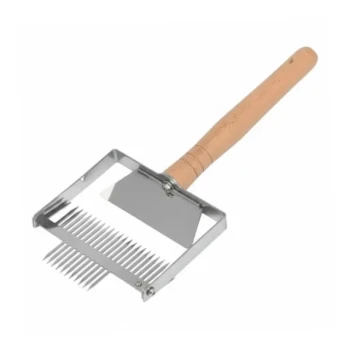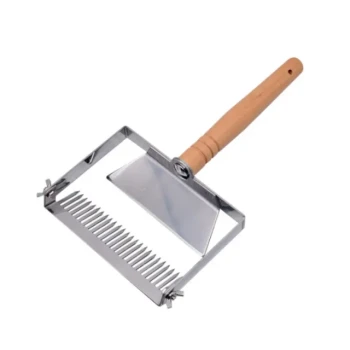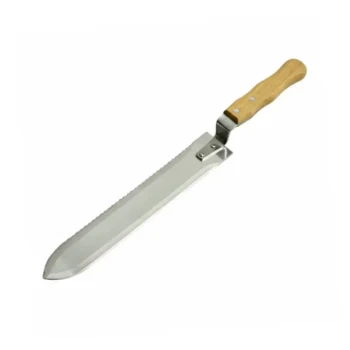To remove beeswax cappings from a honey frame, the two most common tools are a cappings scratcher (or fork) and an uncapping knife, which can be either heated or unheated. The scratcher scrapes or punctures the cell caps, while the knife cleanly slices off the entire top layer of wax to expose the honey for extraction.
The fundamental choice in uncapping tools comes down to your scale. Knives offer speed for larger harvests, while scratchers provide low-cost precision ideal for beginners or those with only a few hives.
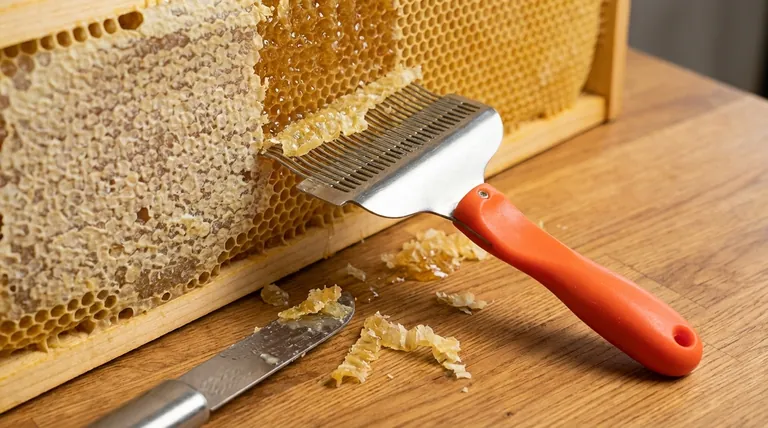
The Primary Uncapping Tools Explained
To prepare frames for honey extraction, you must first open the sealed honeycomb cells. The tool you choose will directly impact the speed and efficiency of this process.
The Uncapping Knife
An uncapping knife is designed to slice off a thin, clean layer of wax cappings from the surface of the frame. This is often the fastest method for processing whole frames.
These knives come in two main varieties: cold (unheated) and electric. An electric knife is heated, allowing it to melt through the wax for a much smoother and quicker cut with less physical effort.
The Cappings Scratcher
Also known as an uncapping fork, this tool has sharp, needle-like tines. Instead of slicing, you use it to scrape, pierce, or flick the wax cappings off the cells.
A scratcher is indispensable for uncapping low spots or uneven areas on the comb that a knife might miss. For beekeepers with only one or two hives, a scratcher alone can be a perfectly sufficient and economical choice.
Specialized Uncapping Tools
While knives and scratchers are most common, other tools exist for specific situations. An uncapping plane is an electric tool that functions like a wood plane, shaving off the cappings as you run it over the frame.
Less common is the uncapping punch, a tool that punctures individual cells rather than removing the cap entirely.
Understanding the Trade-offs
Choosing a tool isn't just about function; it's about balancing cost, speed, and the nature of your harvest.
Speed vs. Cost
An electric uncapping knife is the fastest option for processing many frames, but it represents a higher initial investment.
A cold knife or a cappings scratcher is significantly cheaper but requires more time and manual effort, making it better suited for small-scale operations.
Cleanliness and Wax Collection
Using a knife results in clean sheets of cappings that fall away into a collection tank. This makes it easier to separate the wax from the honey that drips off.
A scratcher can be a messier process, as it shreds the cappings and leaves more "wet" wax mixed with honey. Regardless of the tool, you will need a dedicated pail or uncapping tank to collect the cappings and allow the valuable honey to drain.
Skill and Application
A heated knife requires a steady hand to remove only the cappings without cutting too deep into the comb and wasting honey.
A scratcher is more forgiving and requires less technique, though it can be more physically demanding over several hours. Most beekeepers end up using both: a knife for the main surfaces and a scratcher for cleanup.
Making the Right Choice for Your Harvest
Your decision should be based on the size of your apiary and your long-term goals.
- If your primary focus is a small harvest (1-3 hives): A simple cappings scratcher is the most cost-effective and practical tool to start with.
- If your primary focus is efficiency (4+ hives): An electric uncapping knife is a worthwhile investment that will dramatically reduce your processing time.
- If your primary focus is thoroughness: Always have a cappings scratcher on hand to clean up the recessed areas a knife inevitably misses.
Ultimately, select the tool that aligns with the scale of your work to make your honey harvest a smooth and rewarding experience.
Summary Table:
| Tool | Best For | Key Advantage |
|---|---|---|
| Cappings Scratcher | Small harvests (1-3 hives), beginners | Low cost, forgiving, precise for uneven comb |
| Cold Knife | Small to medium harvests | Cleaner wax collection than a scratcher |
| Electric Knife | Larger harvests (4+ hives), efficiency | Fastest method, reduces manual effort |
Ready to streamline your honey harvest?
For commercial apiaries and beekeeping equipment distributors, the right tools are critical for efficiency and profitability. HONESTBEE supplies professional-grade uncapping knives, scratchers, and other essential beekeeping supplies through our wholesale-focused operations.
Contact our team today to discuss your specific needs and discover how our equipment can help you scale your harvest efficiently.
Visual Guide

Related Products
- Professional Extra-Wide Uncapping Fork with Bent Tines for Beekeeping
- Professional Wide Head Honey Uncapping Fork for Beekeeping
- Extra-Wide All-Stainless Steel Honey Uncapping Fork with T-Handle
- Professional Durable Plastic Handle Honey Uncapping Fork
- Extra Wide Stainless Steel Honey Uncapping Fork with Scraper Beekeeping Tool
People Also Ask
- How does comb depth affect the efficiency of uncapping tools? Match Your Tool for a Faster Harvest
- What are the essential tools for uncapping honey frames? Choose the Right Tool for Your Apiary
- How should honeycombs be prepared for honey extraction? A Step-by-Step Guide to a Clean Harvest
- How long does it take to extract honey from frames? Plan Your Harvest Efficiently
- How do you encourage bees to cap honey? Optimize Hive Conditions for a Perfect Harvest

